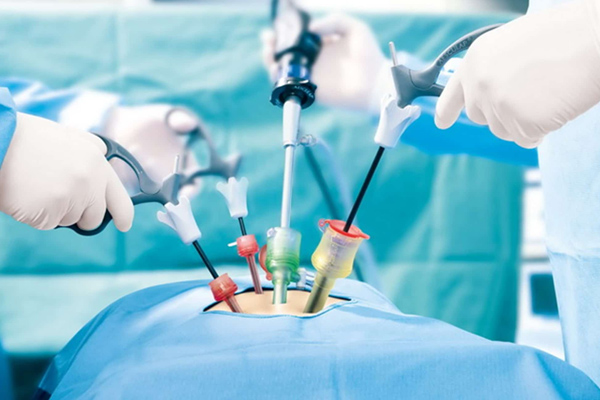
Minimal access surgery is completed with one or more small incisions instead of a large incision. The surgeon passes a telescope with a video camera through a small incision (usually only 1/4" long) into a body cavity. The surgeon then views the surgery on a TV monitor. Surgical instruments are then passed through other similar little incisions. The surgeon examines and operates on the area in question by viewing magnified images on a television. When the telescope is used to operate on the abdomen, the procedure is called laparoscopy. When used in the chest, the procedure is called thoracoscopy, and when used in a joint, it is called arthroscopy.
Endoscopy is a minimally invasive diagnostic tool, used to view the inside of organs, inspect for abnormalities and take biopsies. A small camera and light source are mounted onto a flexible tube which can be inserted into the mouth (to inspect the esophagus, stomach and duodenum) or the anus (to inspect the large bowel).
Upper endoscopy is usually performed to evaluate symptoms of persistent upper abdominal pain, nausea, vomiting, or difficulty swallowing. It is also the best test for finding the cause of bleeding from the upper gastrointestinal tract.
Upper endoscopy is more accurate than x-ray films for detecting inflammation, ulcers, or tumors of the esophagus, stomach and duodenum. Upper endoscopy can detect early cancer and can distinguish between benign and malignant conditions when biopsies of suspicious areas are obtained. Biopsies are taken for many reasons and do not necessarily mean that cancer is suspected.
Upper endoscopy is also used to treat conditions present in the upper gastrointestinal tract. A variety of instruments can be passed through the endoscope that allow many abnormalities to be treated directly with little or no discomfort, for example, stretching narrowed areas, removing polyps (usually benign growths) or swallowed objects, or treating upper gastrointestinal bleeding. Safe and effective endoscopic control of bleeding has reduced the need for transfusions and surgery in many patients.
Laparoscopy is a type of surgery that uses smaller cuts than you might expect.
The process takes its name from the laparoscope, a slender tool that has a tiny video camera and light on the end. When a surgeon inserts it through a small cut and into your body, they can look at a video monitor and see what’s happening inside you. Without those tools, they’d have to make a much larger opening. Thanks to special instruments, your surgeon won’t have to reach into your body, either. That also means less cutting.
Have you heard people talk about “minimally invasive” surgery? Laparoscopic surgery is one kind. Doctors first used it for gallbladder surgery and gynecology operations. Then it came in play for the intestines, liver, and other organs.
Before this system came along, a surgeon who operated on their patient’s belly had to make a cut that was 6-to-12 inches long. That gave them enough room to see what they were doing and reach whatever they had to work on.
In laparoscopic surgery, the surgeon makes several small cuts. Usually, each one is no more than a half-inch long. (That's why it's sometimes called keyhole surgery.) They insert a tube through each opening, and the camera and surgical instruments go through those. Then the surgeon does the operation.
Working this way has several advantages compared with traditional surgery. Because it involves less cutting:
In some operations, the surgeon can put the camera and the surgical tool through the same opening in the skin. This means less scarring. But it’s trickier for the surgeon because the instruments are so close together.
In other cases, the surgeon may decide to use a device that lets them reach in with a hand. This is called “hand assisted” laparoscopy. The cut in the skin has to be longer than a half-inch, but it still can be smaller than in traditional surgery. This has made it possible to use laparoscopic surgery for the liver and other organs.